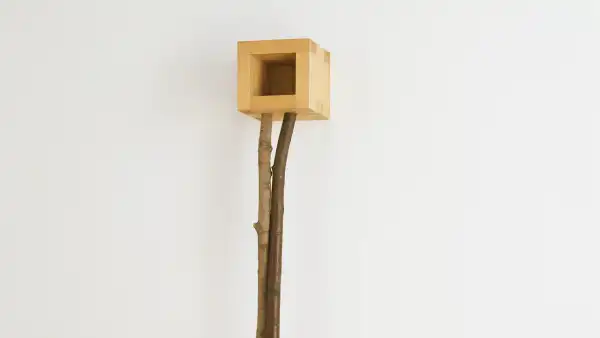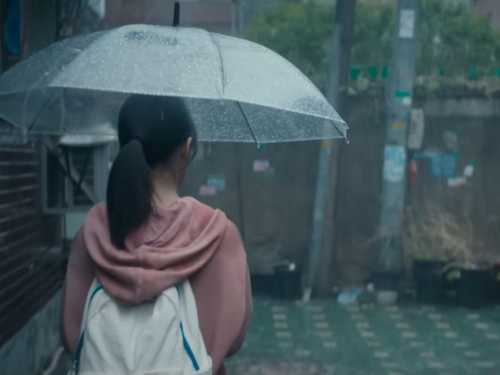
Save this storySave this storySave this storySave this story
A sculpture crafted in 1982 is among the initial pieces viewers will observe in “Nexus,” the Martin Puryear exhibition currently showing at the Museum of Fine Arts in Boston; this was created shortly after a blaze destroyed the bulk of his creations in his workshop. “Sanctuary” comprises a modest pine container, exposed on a solitary surface, resembling a feeder for birds, situated ten feet above ground upon a duo of lengthy, spindly boughs that converge at roughly what would be their ankle joint. At the base, these branches culminate in a pair of paw-shaped feet, secured to the axis of a petite wheel, prepared for locomotion. Despite being entirely composed of lifeless wood, the intertwined branches possess an air of nonchalance, the affixed paws are unsettling, and the improvised notion of security and portability evokes impromptu contemplation.
“Sanctuary” functions as a testament to Puryear’s exceptional artistic merit. It stands as a profound piece of modern art, seemingly extracted from a fairy story—distinct from the predictable Disney variant, embodying instead the whimsical, repurposed aesthetic gathered by the Brothers Grimm, where the lesson is subtle, the inanimate gains sentience, and all involved are forever changed. Born in 1941, Puryear matured in an era when sculpture asserted itself through commanding dimensions, intellectual exactness, and flawlessly precise geometric designs. (Consider Richard Serra, Nancy Holt, and Mark di Suvero.) Briefly, Puryear appeared to align with this trend. In 1979, a mere eight years following his graduation from Yale with an M.F.A., his sculpture “Bask” (1976) was featured on the front page of Artforum. A section of a dark circle stretching across the visual space, curved on one perimeter and linear on the opposing side, could have been mistaken for an Ellsworth Kelly.
However, upon closer inspection, “Bask” bears less resemblance to Kelly and more to a dormant seal: an extended, earth-hugging crest of dyed wood, crafted with strip-planking akin to a hand-built canoe, exhibiting a surprisingly natural essence. “Nexus” showcases numerous similarly refined forms that might casually be labeled “minimalist” yet resist genuine minimalism. “Self” (1978), as an instance, adopts the guise of a sort of elevated hillock, tapering upwards at one extremity. Parallel to “Bask,” it is formed from a casing of somber timber, and at close range, the primary structure reveals itself as constructed from upright staves, while its zenith—agreeably situated at eye level—is capped with layered horizontal circlets. When viewed directly, the entire entity seems to shrug slightly to the right.
 “Big Phrygian,” 2010-14.Art work by Martin Puryear / Courtesy the artist, Matthew Marks Gallery, the Glenstone Museum, and Museum of Fine Arts, Boston
“Big Phrygian,” 2010-14.Art work by Martin Puryear / Courtesy the artist, Matthew Marks Gallery, the Glenstone Museum, and Museum of Fine Arts, Boston
This is an object that seemingly should not possess physical expression, yet it does. Furthermore, from physical expression, it is a rapid transition to individuality. Those acquainted with Tove Jansson’s Moomins might discern in “Self” an echo of the somber and forlorn Groke, trudging through existence with comparable indefinite, almost-shoulders, and a parallel sensation of detachment from the surrounding world. The pattern continues: The sizable outrigger in “Lever #1” (1988-89) is named after a tool but strongly implies a swaying tail. A diminutive, cast-iron sculpture featuring three egg-shaped forms is immediately identifiable as a bird of prey resting upon a stone, concurrently evoking tranquility and impending movement. (Puryear has also received instruction as a trained falconer.)
Indeed, Puryear has consistently remained unconventional. Spanning sixty years, his oeuvre and career have quietly challenged accepted notions regarding the appearance, behavior, and creation of notable artwork. In a period that exalts subcontracted manufacturing, he has invariably favored manual craftsmanship. His tenure with the Peace Corps, in Sierra Leone, along with a two-year immersion in printmaking at the Swedish Royal Academy of Art, facilitated learning from local carpenters, tool creators, and furniture artisans. At a juncture when it was deemed detrimental to permit viewers’ thoughts to deviate from encountering the silent, material manifestation of an abstract piece, Puryear accommodated suggestion. (The eight-foot-tall inverted funnel of “Noblesse O.,” dating back to 1987, can be interpreted as a pure form, yet it would be absurd to dismiss its likeness to the Tin Man’s head covering.) It appears as though, around the nineteen-sixties, Puryear surveyed the components of human existence being excluded from significant art, resolving to invite them all within.
The title of the exhibition gestures toward this accessibility and intricacy, reflecting how, in any Puryear piece, one can select multiple avenues to explore—the overt aesthetic appeal of his shapes and substances; the brilliance of his joining techniques; the parallels and allusions to nature, historical events, and a Black artist’s reflections on Blackness and whiteness. All elements are interconnected. “Nexus” is also the designation of a creation from 1979: a substantial, imperfectly circular ring of cedar that broadens slightly at the point where the two ends—one rendered in black and the other in white—converge. An etching originating from Puryear’s academic years in Stockholm reveals him already experimenting with the mound configuration that would repeatedly appear in diverse forms later on, presented here as a compilation of four uneven blocks—three colored in a speckled beige, and one colored in black—and entitled “Quadroon.” In the exhibition catalogue, the curator Emily Liebert recounts the tale of Puryear’s childhood encounter with John James Audubon’s depictions of two gyrfalcons, one displaying white plumage and the other black, arising from ecological adaptation. “I drew a link concerning human racial divergence through these species,” Puryear stated.
During his upbringing, Puryear harbored aspirations of becoming a wildlife illustrator; during his college years, he initially intended to major in biology prior to transitioning to art. Nature, with its external features and internal framework, remains a consistent presence throughout this display. The informational labels affixed to the wall identify the species of wood employed—Alaskan yellow cedar, Swiss pear, lignum vitae—resembling the acknowledgement of a valued partner. On a more profound level, nature’s intrinsic mechanism of repetition and transformation is similarly employed by Puryear. Across sculptures, drawings, and prints, one can observe the distinct elevation of the “Quadroon” bulge evolving into “Self,” subsequently morphing into something akin to a crouching bear, eventually extending into a shape reminiscent of a preening bird. In the twenty-tens, it expanded and adopted the identifiable drooping shape of a Phrygian cap—a sartorial symbol of freedom throughout both the American and French Revolutions.
 “The Way,” 2022.Art work by Martin Puryear / Courtesy the artist and Matthew Marks Gallery
“The Way,” 2022.Art work by Martin Puryear / Courtesy the artist and Matthew Marks Gallery
The cap is accompanied by respectable fine-art credentials: Delacroix might have overlooked equipping his “Liberty Leading the People” with footwear or a blouse, yet he adorned her with a Phrygian cap. It is also the recognizable head covering of the Smurfs. Puryear’s “Big Phrygian” (2010-14)—vividly red and the dimensions of a ride-on lawnmower—maintains both these legacies in view, even as one’s gaze is captivated by precisely how segments of red cedar are structured to yield the impression of substantial delicate pleats. Puryear possesses expertise as a woodworker, a printmaker, a sketch artist, and even as a falconer; nonetheless, his foremost endowment as an artist lies in his aptitude for maintaining all these attributes actively engaged concurrently.
He could indeed be acknowledged as America’s preëminent living sculptor, and his accomplishments have undoubtedly garnered substantial recognition—a MacArthur Fellowship during his forties, a MoMA retrospective in his sixties, along with representing the American pavilion at the Venice Biennale during his seventies. Nonetheless, in certain ways, he appears to remain underrated. Possibly this is attributable to his deliberate pace, resulting in a limited quantity of his artwork to cultivate consistent enthusiasm; or perhaps it stems from the meticulous construction of his pieces, and the term “craft” can elicit unease among intellectually inclined art observers; or it may be that his art offers resistance to facile, definitive clarification.
This, naturally, encapsulates the essence. Puryear does not adopt a domineering stance. The remarkable facet of his creations resides not in the information conveyed, but rather in the manner by which it can consolidate attention in a specific location and redirect it elsewhere. It would be inaccurate to assert that objects are not consistently what they seem, although it is precise to acknowledge that they transcend mere superficial appearance. One of the particularly enthralling recent pieces featured in “Nexus” is “The Way” (2022). Emerging from a diminutive block shaped akin to a covered wagon lacking wheels, an elongated sapling arcs approximately eight feet upwards, providing a platform for a slender rod extending forward (or potentially backward, contingent upon perspective). The original rendition of this composition was conceived, akin to “Sanctuary,” from a disarranged assortment of constituents: a maple sapling, a willow shoot, a substructure of pine and curly maple. However, this particular artwork is cast in bronze, bestowing its whimsical arrangement with consequence. Sticks and stones may proceed as desired, but bronze is associated with monuments. It communicates across both the past and present, imparting momentous messages.
Regarding the essence of these messages? In a melancholic mood, viewing “The Way” as the despondent aftermath of “Sanctuary”—the wheels have detached, the refuge is sealed off, and the petitioner is directed elsewhere—is conceivable. However, a feature of the work’s improbable equilibrium—the modest, understated foundation exerting sufficient gravitational force to maintain the entirety aloft—imparts vitality to the atmosphere encompassing it. Resembling a toddler fervently indicating something the mature sphere overlooked long ago, or sensing the enchantment of, there lies latent influence within that insistent expression, that requirement for mindfulness. ♦
Sourse: newyorker.com






